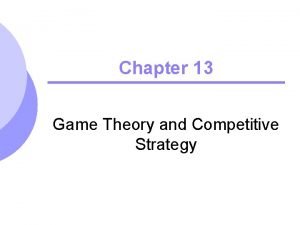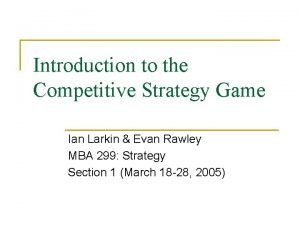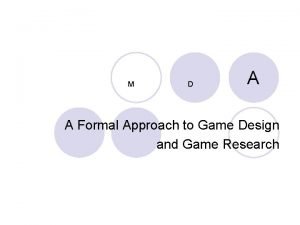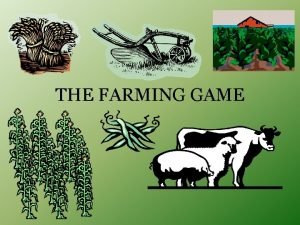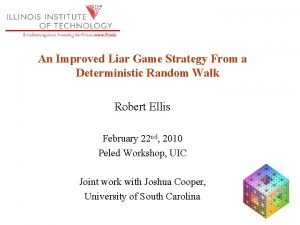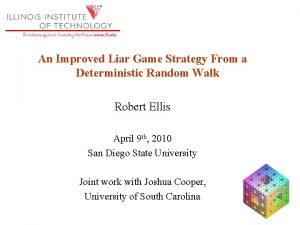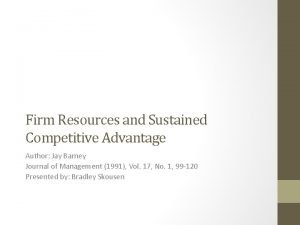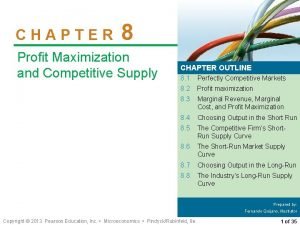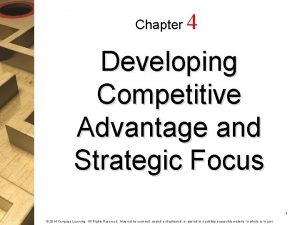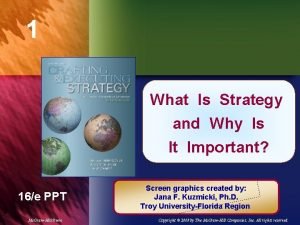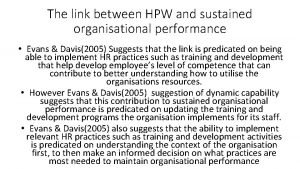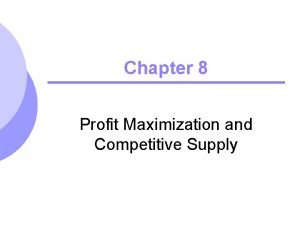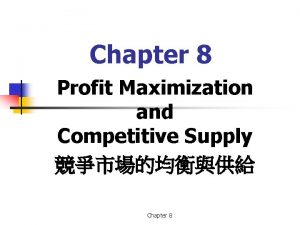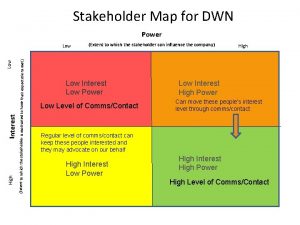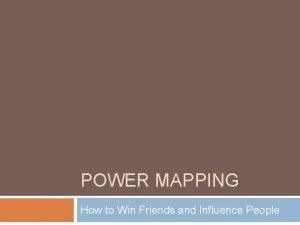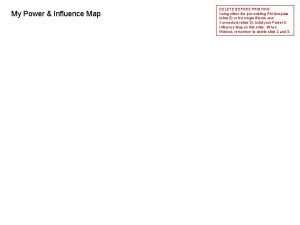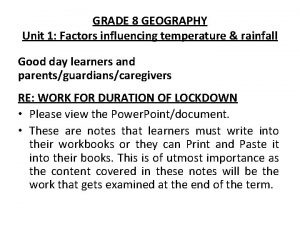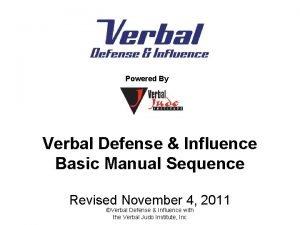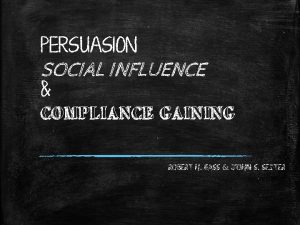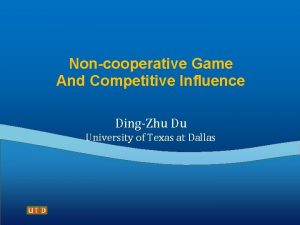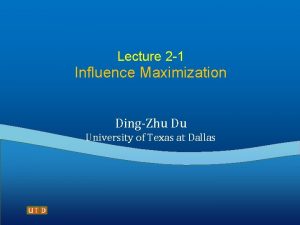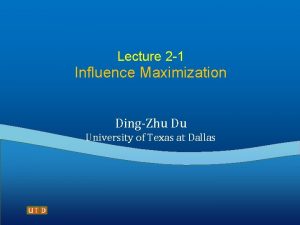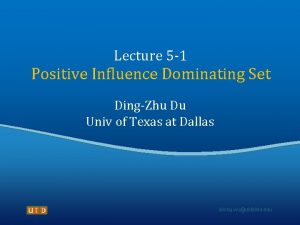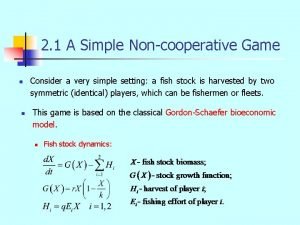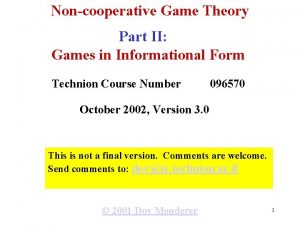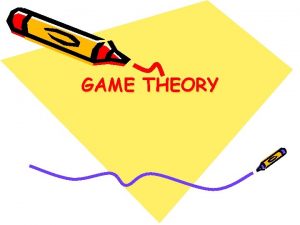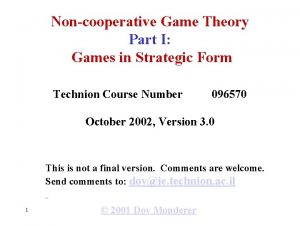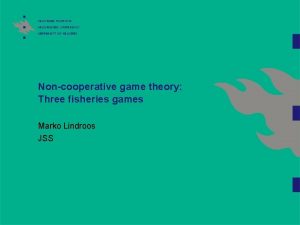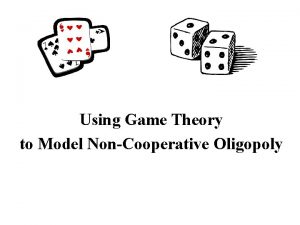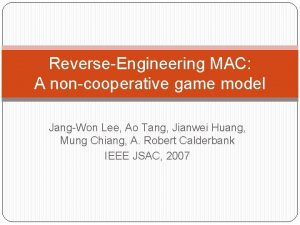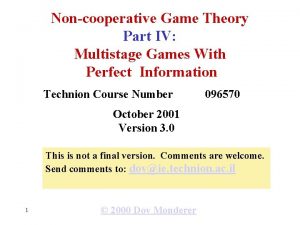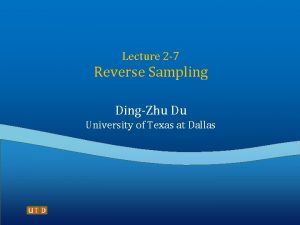Noncooperative Game And Competitive Influence DingZhu Du University







































- Slides: 39

Non-cooperative Game And Competitive Influence Ding-Zhu Du University of Texas at Dallas

Outline • Non-cooperative Game • Competitive Influence • Approximate Nash Equilibrium 2

“Decisions are made by a set of noncooperative agents whose action spaces are subsets of an underlying groundset. The actions of the agents induce some social utility, measured by a set function. The goal of the agents, though, is not to maximize the overall social utility; rather, they seek to maximize their own private utility functions. ” The only assumptions we make are • The social utility and private utility functions are measured in the same standard unit 3

Mathematical Formulation 4

groundset actions acts 5

Notations 6

Notations 7

Utility Functions 8

Nash Equilibrium Theorem (Nash, 1951) 9

A Beautiful Mind- John Nash 10

Utility System 11

Valid Utility System 12

Basic Utility System Theorem 13

Proof of basic => valid Submodularity basic 14

Remark 15

Lemma 16

Union and subtraction 17

Proof Submodular 18

Theorem 19

Proof utility system Valid utility system 20

Theorem 21

Proof 22

Outline • Non-cooperative Game • Competitive Influence • Approximate Nash Equilibrium 23

Independent Cascade (IC) Model • When node v becomes active, it has a single chance of activating each currently inactive neighbor w. • The activation attempt succeeds with probability pvw. • The deterministic model is a special case of IC model. In this case, pvw =1 for all (v, w).

Example Y 0. 6 Inactive Node 0. 3 0. 2 X 0. 4 0. 5 w 0. 2 U 0. 1 0. 3 0. 2 0. 5 v Stop! Active Node Newly active node Successful attempt Unsuccessful attempt

IC Model (Competitive Version) • each of b players selects a color and a set Si of at most ki nodes. • A node activated by players with one color will take the color. • A node activated by players with multi-color will take the color of one of the players uniformly at random. • Process ends until no new activations occur. 26

Example 2 6 1 5 3 4 Two players red and green. Step 1: 1 --2, 6 --2. 2 becomes red or green. 10/27/2020 27

Example 2 6 1 5 3 4 Step 2: 1 --3, 6 --2. 3 becomes red. 10/27/2020 28

Example 2 6 1 5 3 4 Step 3: 1 --2, 3 --4, 6 --4. 4 becomes red or green. 10/27/2020 29

Example 2 6 1 5 3 4 Step 4: 1 --3, 3 --2, 6 --4, 4 --5. 5 is protected. 10/27/2020 30

Example 2 6 1 5 3 4 end: no more node can be activated. 10/27/2020 31

Lemma 32

Lemma This lemma seems useless? It can be used later! 10/27/2020 33

Game • • Each node is an act. Each action for player i is a subset of ki nodes. Private utility function Social utility function 34

Valid Utility system Theorem Proof Nondecreasing 35

Outline • Non-cooperative Game • Competitive Influence • Approximate Nash Equilibrium 36

Theorem 37

Corollary 38

Thank you! 10/27/2020 39
 Competitive antagonist
Competitive antagonist Market commonality and resource similarity examples
Market commonality and resource similarity examples The two least common competitive structures are
The two least common competitive structures are Chapter 13 game theory and competitive strategy
Chapter 13 game theory and competitive strategy Competitive strategy game
Competitive strategy game A formal approach to game design and game research
A formal approach to game design and game research Pirate game grid
Pirate game grid Farming game rules pdf
Farming game rules pdf Game lab game theory
Game lab game theory Liar game game theory
Liar game game theory Liar game game theory
Liar game game theory 詹景裕
詹景裕 Society of competitive intelligence
Society of competitive intelligence Firm resources and sustained competitive advantage barney
Firm resources and sustained competitive advantage barney In identifying company resources with competitive value
In identifying company resources with competitive value Entrepreneurial strategy and competitive dynamics
Entrepreneurial strategy and competitive dynamics Profit maximization and competitive supply
Profit maximization and competitive supply Developing competitive advantage and strategic focus
Developing competitive advantage and strategic focus Market and competitive space
Market and competitive space Porters 3 generic strategy
Porters 3 generic strategy Competitive strengths assessment
Competitive strengths assessment A company's strategy can be considered ethical
A company's strategy can be considered ethical Link between hpw and competitive advantage
Link between hpw and competitive advantage Profit maximizing output
Profit maximizing output Profit maximization and competitive supply
Profit maximization and competitive supply Stakeholder analysis
Stakeholder analysis Power and influence mapping
Power and influence mapping Power and influence mapping
Power and influence mapping Influence and passivity in social media
Influence and passivity in social media Patterns of group interaction and communication
Patterns of group interaction and communication 5 factors that influence temperature and rainfall grade 8
5 factors that influence temperature and rainfall grade 8 Sphere of control and influence
Sphere of control and influence Stakeholder classification
Stakeholder classification Apa itu social thinking
Apa itu social thinking Verbal judo leaps
Verbal judo leaps Borderline persuasion examples
Borderline persuasion examples Describe a.l. washburn’s study.
Describe a.l. washburn’s study. Factor influence communication
Factor influence communication This is a sensational style of writing that exaggerates
This is a sensational style of writing that exaggerates Social thinking and social influence
Social thinking and social influence



